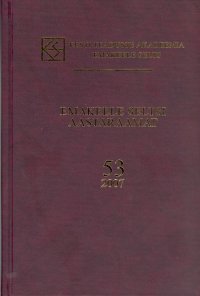Joko lingvistin nojatuoli joutaisi kaatopaikalle? Introspektiolingvistiikan asemasta kognitiivisessa kielitieteessä
On the debate about introspection as a research method in cognitive linguistics
Author(s): Tuomas HuumoSubject(s): Language and Literature Studies
Published by: Teaduste Akadeemia Kirjastus
Keywords: corpus research; empirical; introspection; cognitive linguistics
Summary/Abstract: The article discusses an ongoing methodological debate concerning introspection and its use in cognitive linguistics. Introspection is a classical linguistic method where the linguist uses his/her native speaker intuition to make up examples and to give judgements concerning the grammaticality and meaning of linguistic expressions. This methodology is usually taken for granted in generative and other formalist schools of linguistics, which emphasize the distinction between an abstract linguistic system (considered the primary research object of linguistics) and concrete language usage (considered a secondary research object). Recently this view has been challenged by functional and cognitive linguists, who emphasize the central role of language use in the development of the linguistic system and also the usagebased nature of grammar. Within cognitive linguistics, corpus linguists like Dirk Geeraerts (1999, 2006) have challenged the classical methodology and argued that to develop into an „empirical science”, cognitive linguistics needs to give up the classical method altogether and to start using empirical methods only. On the other hand, Leonard Talmy (2007) has recently defended the introspective method and argued for its ubiquitous nature in the study of linguistic meaning. Talmy discusses the method in detail and evaluates its strong and weak sides. He also evaluates the degree of accessibility through introspection of many linguistic phenomena. The current author makes the point that introspective data based on fabricated examples should not be taken to represent language use but the linguistic system itself (de Saussure’s langue). In spite of certain drawbacks that admittedly go with fabricated examples, such data has certain advantages over corpora. For instance, fabricated examples are structurally simple and context-free, and can be freely manipulated to form minimal pairs and to test the specifi c function and semantic controbution of a particular element for the whole expression. However, the present author is also skeptical towards the common (formalist) practice of using extremely complex and unnatural fabricated examples as the basis of linguistic argumentation.
Journal: Emakeele Seltsi aastaraamat
- Issue Year: 2007
- Issue No: 53
- Page Range: 163-180
- Page Count: 18
- Language: Finnish

